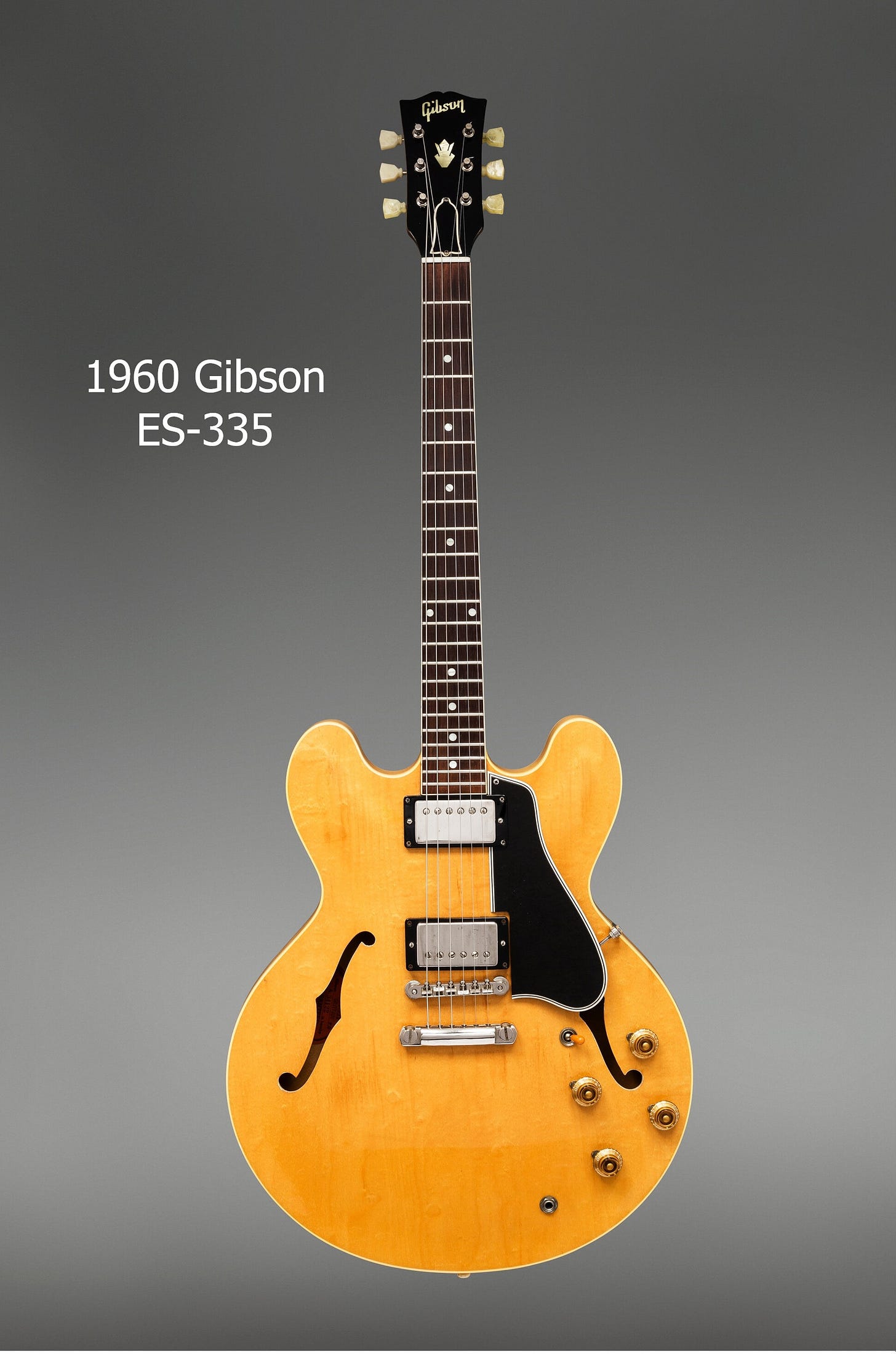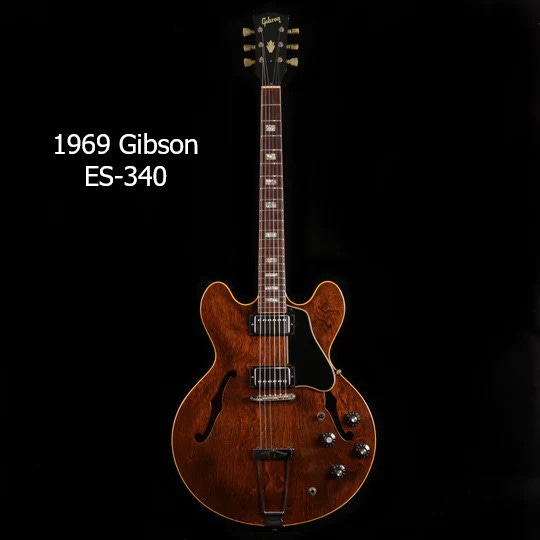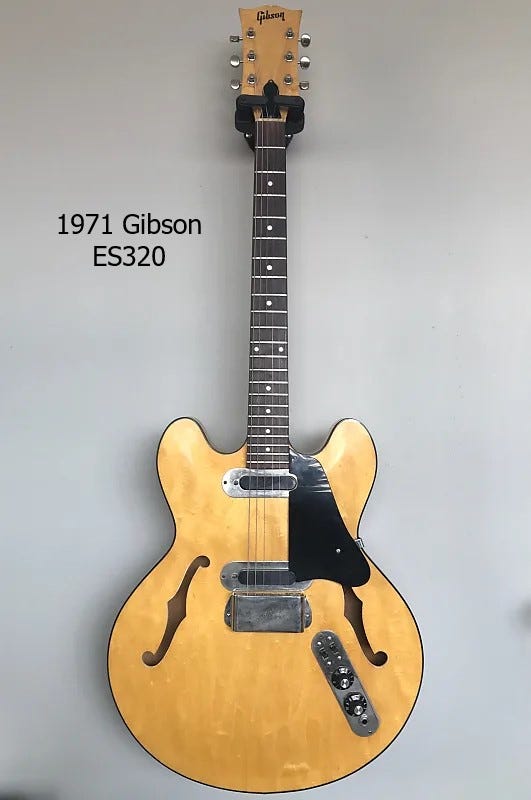Guitar Gavel “Lick Of The Week” with Christos Fragias. A clinic on “keys”
Live from Australia, the Frag is back! Christos Fragias discusses different keys and their influence on the tonality spectrum of a song invoking Vivian Campbell and Steve Morse as examples.
Plus he gives us a straightforward little exercise to put it into practice. Thank you Christos for your beautiful spirit and time spent sharing this lesson.
I’ll admit it, Gibson’s thinline electrics seem intimidating. I mean, it feels like there’s a gazillion different models when there really isn’t… but there kind of are. When I hear “thinline” I think Chuck Berry and B.B. King, others may think Billy Byrd and Hank Garland.
The “ES” nomenclature from Gibson stands for “Electric Spanish” and the company began using it in 1936 to differentiate from their “Electric Hawaiian” (EH) guitars. The very first ES guitar from Gibson was the ES-150 in 1936, essentially an electrified version of their L-50 archtop, and a counterpart to the EH-150 lap steel.
I bring up the ES-150 to demonstrate a point, and likely the unconscious reason why it feels to me there are so many Gibson ES thinline models. The ES designation by Gibson began eighty-six years ago and YES, it is used on a ton of models from full-depth jazz boxes and archtops to true “thinlines” to the semi-solid guitars popularized in the late 1950s.
In this article we will look at the more legendary rock n’ roll semi-hollow thinlines from the 1950s and 60s. The “standard” guitars that most of us think about when Gibson semi-hollows come up in conversation. And just to provide you with a gut check, most of these are semi-solid with a core maple block, not semi-hollow so I’ll use the term “semi-solid” moving forward with reference to these guitars. They are the ES-335, ES-345, and ES-355. For good measure I’m throwing in the ES-320, 325, 330, and 340, but the focus is on the “Big 3”.
And another important clarification is needed. Technically speaking, Gibson’s first “thinlines” were introduced in 1955. These guitars were still of hollow-body construction, but the depth of the body was reduced by about half and narrowed the gap between the new solid body Les Paul and the historically thick full hollow-bodies. The first of these models were the ES-225T, Byrdland, and ES-350T.
The “Big 3”
So here it is, the mid 1950s and Gibson has their traditional big hollow-body electrics, the new solid-body Les Paul series, and brand new thinlines. What’s missing? A hybrid guitar with a solid-body sound, yet one that retains more of an acoustic feel. Remember, solid-body guitars were new to the world and part of the market was not ready to go “all-in” that direction. Gibson was looking to fill a market void.
In 1957, Ted McCarty, President of Gibson and his design team started working on a solution for the mystery instrument and it began with a solid maple core.
Ted McCarty referencing the design- “I came up with the idea of putting a solid block of maple in an acoustic model to get some of the same tone as a regular solid body, plus the instrument’s hollow wings would vibrate and we’d get a combination of an electric solid body and a hollow body guitar.”
Another of Gibson’s intent was to reduce feedback produced by hollow-bodies at higher volumes yet retain the warm sound of a solid body. The mission was accomplished with the introduction of the ES-335 in 1958. It had a laminated maple top, back and sides. A solid mahogany neck, unbound rosewood fretboard with pearl dot inlays and PAF humbuckers. A Bigsby tremolo option quickly followed. The dimensions are 16” x 19” x 1 3/4” thick and remain the same through the three models discussed below with the neck joining the body at the 19th fret.
In March of 1959 a fancier version of the 335 hit the streets, the ES-355. It sported gold hardware, fancy bindings, a bound ebony fretboard with block inlays, Grover tuners and a Bigsby was more or less standard. The headstock also received the same split-diamond insignia reserved for Gibson’s highest end offerings, the Les Paul Custom and Super 400.
Before the end of 1959 a second version of the 355, the ES-355 TDVS was introduced. This is when the Varitone rotary switch appeared along with a stereo output. It can get a little confusing because a limited number of special order 335’s also had a Varitone switch.
Then there is the ES-345 which also came out in 1959. It’s basically a middle-tier guitar between the 335 and 355 with a blend of aesthetics from the two. First and foremost like the 355 TDVS, it too had a Varitone switch with stereo output and gold hardware. The headstock was not as fancy as the 355 and it had a rosewood fretboard in common with the 335. Two distinguishing features are the parallelogram inlays and a skinnier neck.
The “Big 3” in summary
The ES-335 was Gibson’s “standard” offering, think Toyota Camry, while the 345 was a Toyota Avalon, and the 355 was a Lexus. Among the models there were subtle changes throughout the first decade or so generalized by pick guard sizes, neck thickness, inlays, tremolo, and even a minor horn shape change. (That is not a comprehensive list). When it comes to classic semi-solid Gibson’s those three models are the ones most people talk about and are the most collectable. If you weren’t before, consider yourself in the loop. Continue reading for the remaining vintage Gibson thinlines.
Other Vintage Gibson Thinlines
Another thinline from 1959, though not a semi-solid, but a pure hollow-body was the ES-330. The body was the same as its semi-solid cousins, but a trapeze tailpiece was standard and pickups were P-90s (single or double). Without trying to open Pandora’s box with the Epiphone equivalents of these guitars it’s worth noting in this case, the Epiphone Casino is Epi’s version of the 330.
Here are three more vintage ES thinline class guitars to be familiar with, though they were introduced about a decade later, all but the ES-340 were under Norlin’s leadership.
The ES-340 debuted in 1968 and discontinued in 1974 and it was a true semi-solid. This one had a birch body, maple neck, and trapeze tailpiece. The most interesting aspect is the wiring. The 3-way switch was wired to be in-phase/out-of-phase/off and the pickup selection was controlled with a pickup blend knob in place of a separate tone. Therefore, the controls consisted of two volumes, one master tone, and a pickup blender.
One major oddball came in 1971 (surely a Norlin brilliant idea), the ES-320, and it barely lasted three years. I believe it has semi-solid construction with a maple body and mahogany neck like the 335. For better or worse the pickups were Melody Maker style single coils. The pickups were selected by individual switches with a master volume and tone control.
Lastly, in 1972 Gibson made the ES-325. This one was a full hollow-body style with mini-humbuckers, one f-hole, trapeze tailpiece and a half circle plastic control plate with standard 2 volume and 2 tone controls, 3-way switch.
Note- There are subsequent modern ES guitars and were not the focus of this article. Wikipedia has a solid listing of all ES models that can be found here.











3 comments
You didn’t mention the es 346 Paul Jackson model.
Thank you James!
Excellent. Very Informative, as always, thanks very much.